Workplace Safety and Procedures
VerifiedAdded on 2020/12/07
|10
|1474
|290
Homework Assignment
AI Summary
This assignment focuses on workplace safety practices and procedures. It emphasizes the importance of personal protective equipment (PPE), hazard identification and risk assessment, safe work methods, and emergency response protocols. Students are expected to demonstrate their understanding of various safety regulations and guidelines applicable to different work environments.
Contribute Materials
Your contribution can guide someone’s learning journey. Share your
documents today.
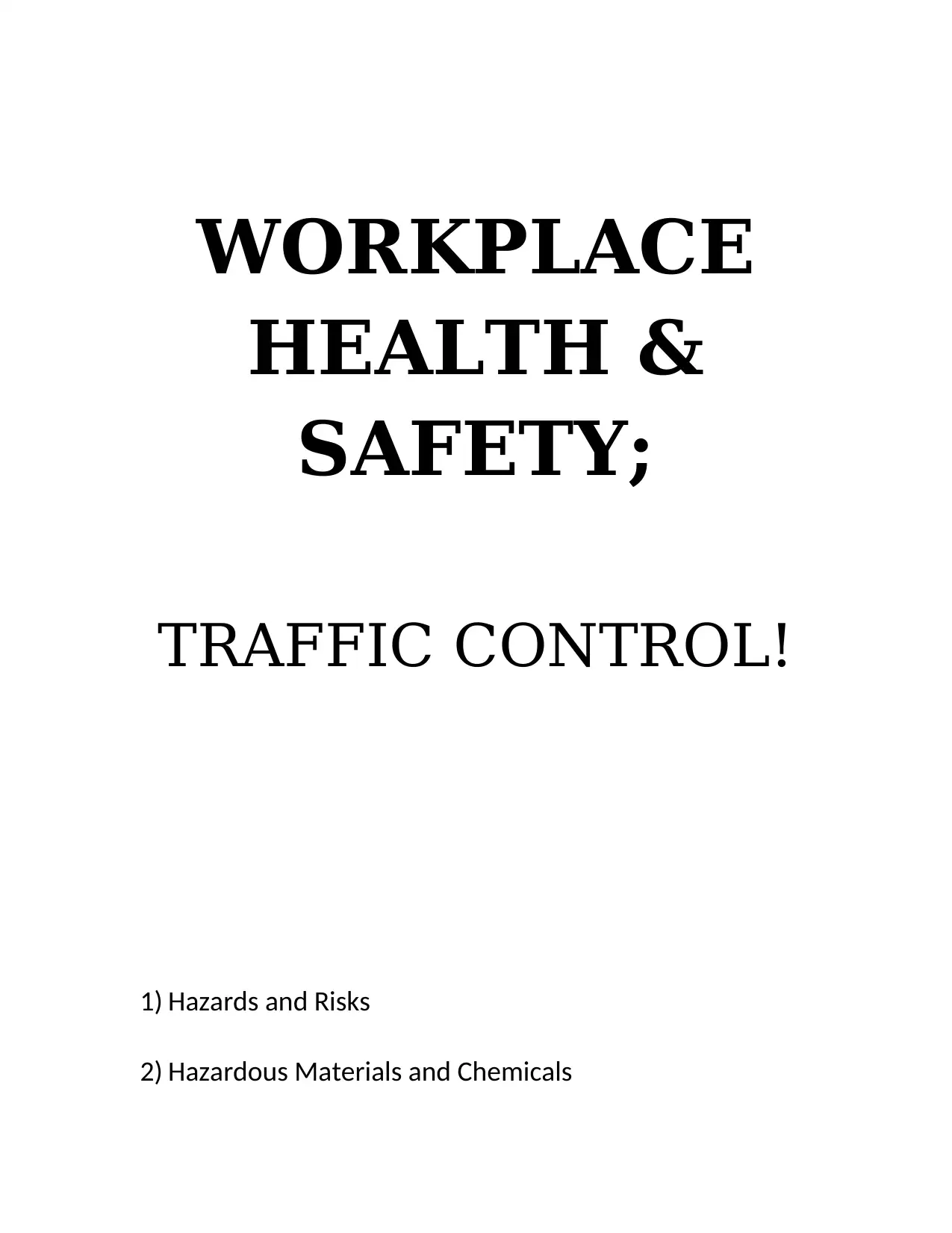
WORKPLACE
HEALTH &
SAFETY;
TRAFFIC CONTROL!
1) Hazards and Risks
2) Hazardous Materials and Chemicals
HEALTH &
SAFETY;
TRAFFIC CONTROL!
1) Hazards and Risks
2) Hazardous Materials and Chemicals
Secure Best Marks with AI Grader
Need help grading? Try our AI Grader for instant feedback on your assignments.
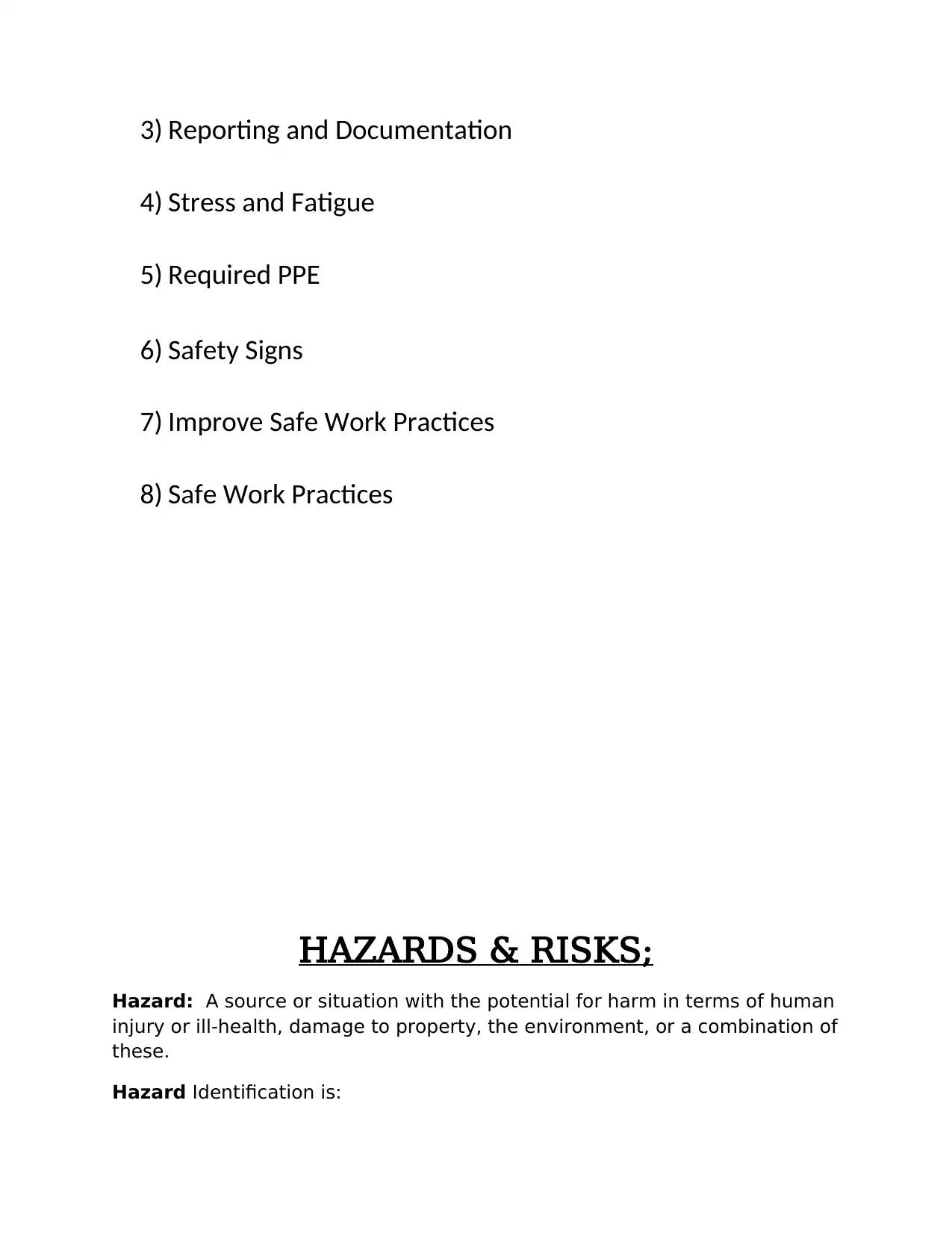
3) Reporting and Documentation
4) Stress and Fatigue
5) Required PPE
6) Safety Signs
7) Improve Safe Work Practices
8) Safe Work Practices
HAZARDS & RISKS;
Hazard: A source or situation with the potential for harm in terms of human
injury or ill-health, damage to property, the environment, or a combination of
these.
Hazard Identification is:
4) Stress and Fatigue
5) Required PPE
6) Safety Signs
7) Improve Safe Work Practices
8) Safe Work Practices
HAZARDS & RISKS;
Hazard: A source or situation with the potential for harm in terms of human
injury or ill-health, damage to property, the environment, or a combination of
these.
Hazard Identification is:
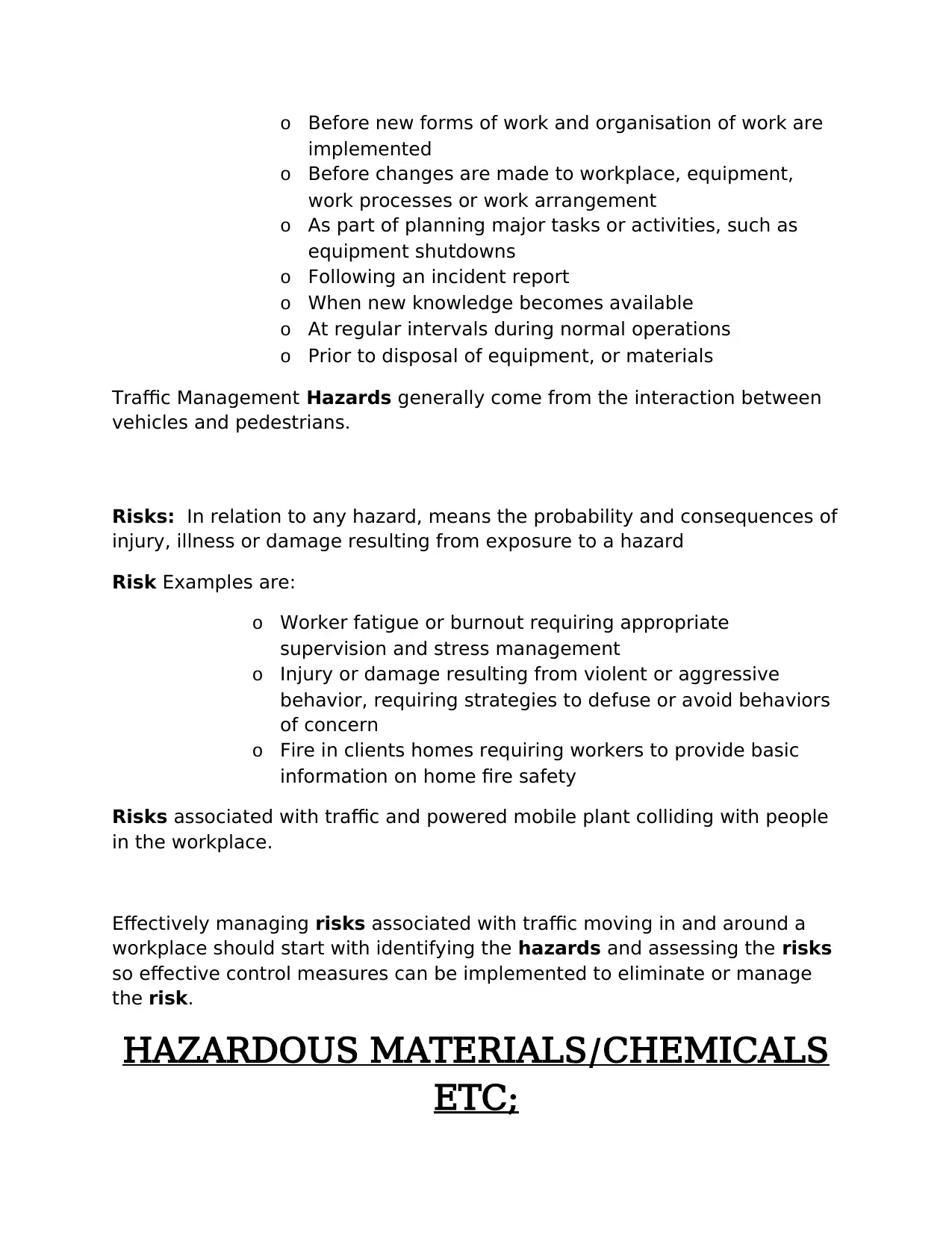
o Before new forms of work and organisation of work are
implemented
o Before changes are made to workplace, equipment,
work processes or work arrangement
o As part of planning major tasks or activities, such as
equipment shutdowns
o Following an incident report
o When new knowledge becomes available
o At regular intervals during normal operations
o Prior to disposal of equipment, or materials
Traffic Management Hazards generally come from the interaction between
vehicles and pedestrians.
Risks: In relation to any hazard, means the probability and consequences of
injury, illness or damage resulting from exposure to a hazard
Risk Examples are:
o Worker fatigue or burnout requiring appropriate
supervision and stress management
o Injury or damage resulting from violent or aggressive
behavior, requiring strategies to defuse or avoid behaviors
of concern
o Fire in clients homes requiring workers to provide basic
information on home fire safety
Risks associated with traffic and powered mobile plant colliding with people
in the workplace.
Effectively managing risks associated with traffic moving in and around a
workplace should start with identifying the hazards and assessing the risks
so effective control measures can be implemented to eliminate or manage
the risk.
HAZARDOUS MATERIALS/CHEMICALS
ETC;
implemented
o Before changes are made to workplace, equipment,
work processes or work arrangement
o As part of planning major tasks or activities, such as
equipment shutdowns
o Following an incident report
o When new knowledge becomes available
o At regular intervals during normal operations
o Prior to disposal of equipment, or materials
Traffic Management Hazards generally come from the interaction between
vehicles and pedestrians.
Risks: In relation to any hazard, means the probability and consequences of
injury, illness or damage resulting from exposure to a hazard
Risk Examples are:
o Worker fatigue or burnout requiring appropriate
supervision and stress management
o Injury or damage resulting from violent or aggressive
behavior, requiring strategies to defuse or avoid behaviors
of concern
o Fire in clients homes requiring workers to provide basic
information on home fire safety
Risks associated with traffic and powered mobile plant colliding with people
in the workplace.
Effectively managing risks associated with traffic moving in and around a
workplace should start with identifying the hazards and assessing the risks
so effective control measures can be implemented to eliminate or manage
the risk.
HAZARDOUS MATERIALS/CHEMICALS
ETC;
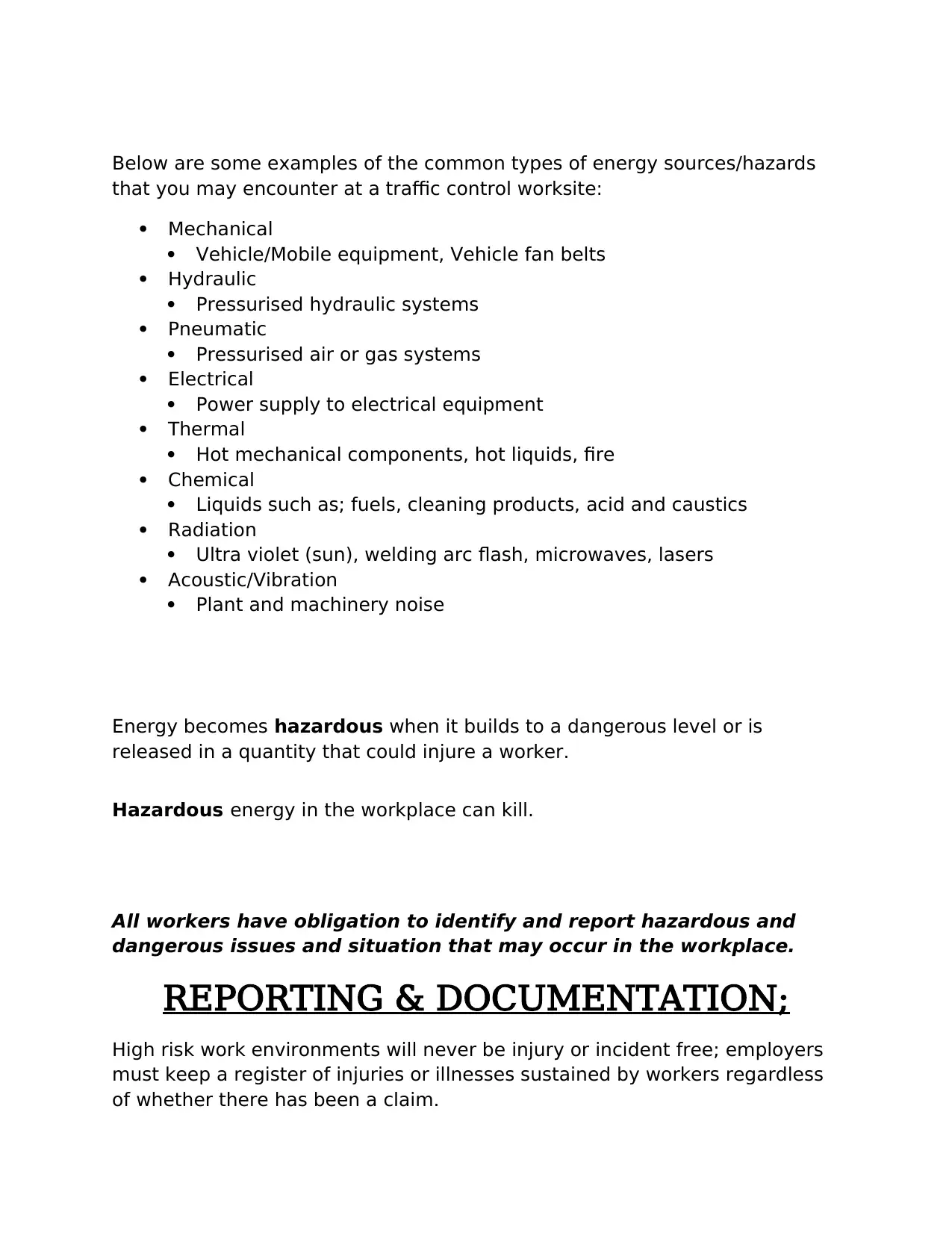
Below are some examples of the common types of energy sources/hazards
that you may encounter at a traffic control worksite:
Mechanical
Vehicle/Mobile equipment, Vehicle fan belts
Hydraulic
Pressurised hydraulic systems
Pneumatic
Pressurised air or gas systems
Electrical
Power supply to electrical equipment
Thermal
Hot mechanical components, hot liquids, fire
Chemical
Liquids such as; fuels, cleaning products, acid and caustics
Radiation
Ultra violet (sun), welding arc flash, microwaves, lasers
Acoustic/Vibration
Plant and machinery noise
Energy becomes hazardous when it builds to a dangerous level or is
released in a quantity that could injure a worker.
Hazardous energy in the workplace can kill.
All workers have obligation to identify and report hazardous and
dangerous issues and situation that may occur in the workplace.
REPORTING & DOCUMENTATION;
High risk work environments will never be injury or incident free; employers
must keep a register of injuries or illnesses sustained by workers regardless
of whether there has been a claim.
that you may encounter at a traffic control worksite:
Mechanical
Vehicle/Mobile equipment, Vehicle fan belts
Hydraulic
Pressurised hydraulic systems
Pneumatic
Pressurised air or gas systems
Electrical
Power supply to electrical equipment
Thermal
Hot mechanical components, hot liquids, fire
Chemical
Liquids such as; fuels, cleaning products, acid and caustics
Radiation
Ultra violet (sun), welding arc flash, microwaves, lasers
Acoustic/Vibration
Plant and machinery noise
Energy becomes hazardous when it builds to a dangerous level or is
released in a quantity that could injure a worker.
Hazardous energy in the workplace can kill.
All workers have obligation to identify and report hazardous and
dangerous issues and situation that may occur in the workplace.
REPORTING & DOCUMENTATION;
High risk work environments will never be injury or incident free; employers
must keep a register of injuries or illnesses sustained by workers regardless
of whether there has been a claim.
Secure Best Marks with AI Grader
Need help grading? Try our AI Grader for instant feedback on your assignments.
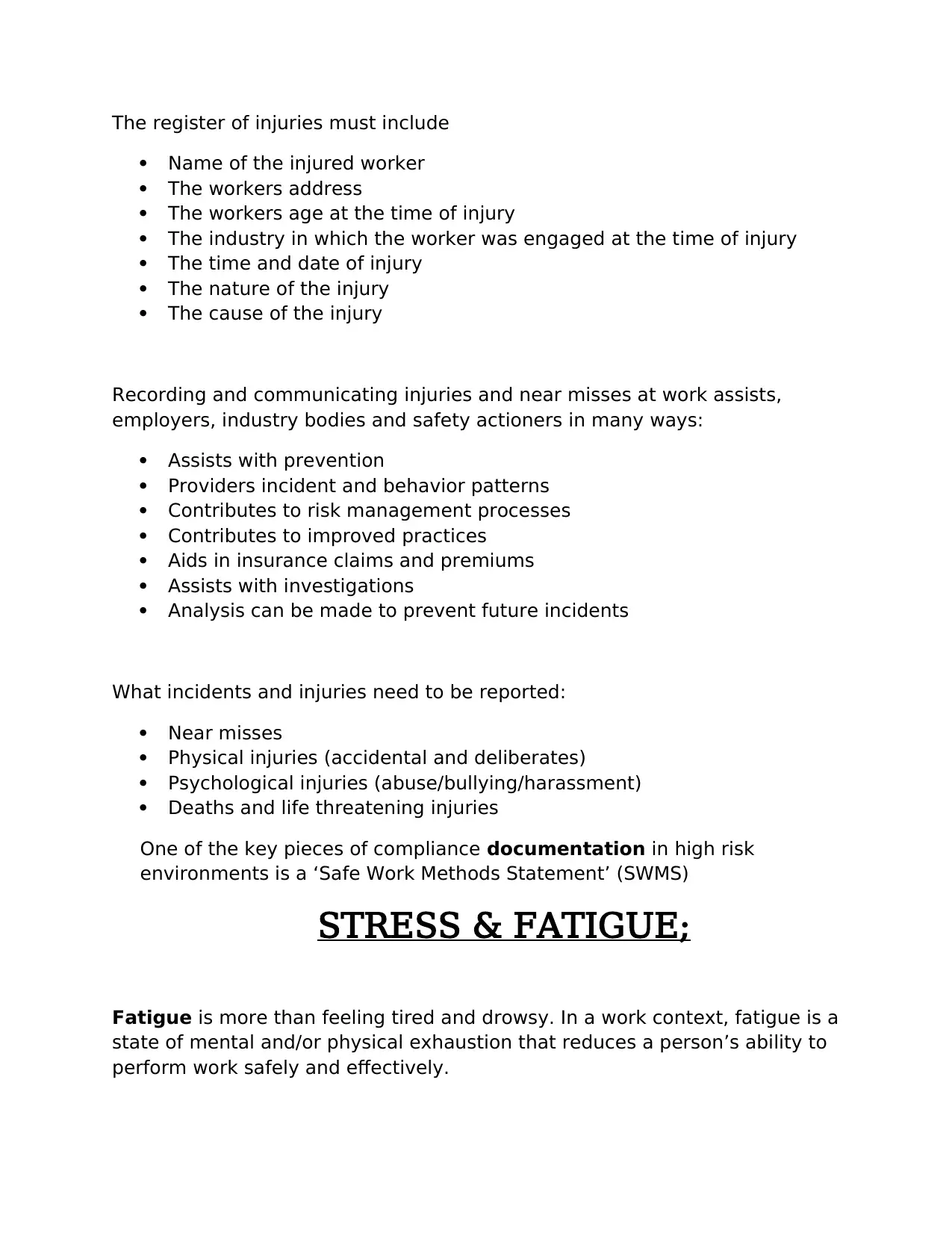
The register of injuries must include
Name of the injured worker
The workers address
The workers age at the time of injury
The industry in which the worker was engaged at the time of injury
The time and date of injury
The nature of the injury
The cause of the injury
Recording and communicating injuries and near misses at work assists,
employers, industry bodies and safety actioners in many ways:
Assists with prevention
Providers incident and behavior patterns
Contributes to risk management processes
Contributes to improved practices
Aids in insurance claims and premiums
Assists with investigations
Analysis can be made to prevent future incidents
What incidents and injuries need to be reported:
Near misses
Physical injuries (accidental and deliberates)
Psychological injuries (abuse/bullying/harassment)
Deaths and life threatening injuries
One of the key pieces of compliance documentation in high risk
environments is a ‘Safe Work Methods Statement’ (SWMS)
STRESS & FATIGUE;
Fatigue is more than feeling tired and drowsy. In a work context, fatigue is a
state of mental and/or physical exhaustion that reduces a person’s ability to
perform work safely and effectively.
Name of the injured worker
The workers address
The workers age at the time of injury
The industry in which the worker was engaged at the time of injury
The time and date of injury
The nature of the injury
The cause of the injury
Recording and communicating injuries and near misses at work assists,
employers, industry bodies and safety actioners in many ways:
Assists with prevention
Providers incident and behavior patterns
Contributes to risk management processes
Contributes to improved practices
Aids in insurance claims and premiums
Assists with investigations
Analysis can be made to prevent future incidents
What incidents and injuries need to be reported:
Near misses
Physical injuries (accidental and deliberates)
Psychological injuries (abuse/bullying/harassment)
Deaths and life threatening injuries
One of the key pieces of compliance documentation in high risk
environments is a ‘Safe Work Methods Statement’ (SWMS)
STRESS & FATIGUE;
Fatigue is more than feeling tired and drowsy. In a work context, fatigue is a
state of mental and/or physical exhaustion that reduces a person’s ability to
perform work safely and effectively.
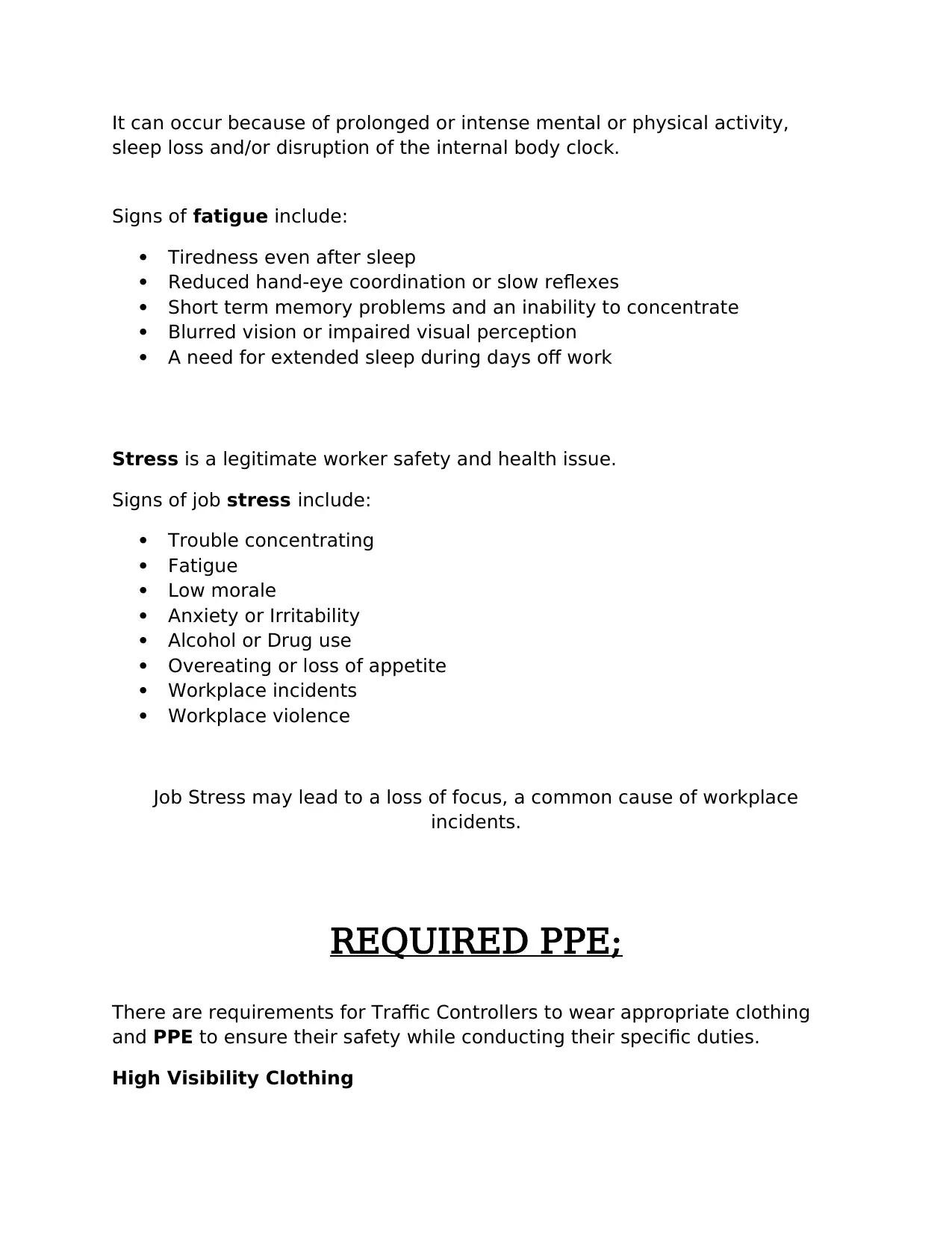
It can occur because of prolonged or intense mental or physical activity,
sleep loss and/or disruption of the internal body clock.
Signs of fatigue include:
Tiredness even after sleep
Reduced hand-eye coordination or slow reflexes
Short term memory problems and an inability to concentrate
Blurred vision or impaired visual perception
A need for extended sleep during days off work
Stress is a legitimate worker safety and health issue.
Signs of job stress include:
Trouble concentrating
Fatigue
Low morale
Anxiety or Irritability
Alcohol or Drug use
Overeating or loss of appetite
Workplace incidents
Workplace violence
Job Stress may lead to a loss of focus, a common cause of workplace
incidents.
REQUIRED PPE;
There are requirements for Traffic Controllers to wear appropriate clothing
and PPE to ensure their safety while conducting their specific duties.
High Visibility Clothing
sleep loss and/or disruption of the internal body clock.
Signs of fatigue include:
Tiredness even after sleep
Reduced hand-eye coordination or slow reflexes
Short term memory problems and an inability to concentrate
Blurred vision or impaired visual perception
A need for extended sleep during days off work
Stress is a legitimate worker safety and health issue.
Signs of job stress include:
Trouble concentrating
Fatigue
Low morale
Anxiety or Irritability
Alcohol or Drug use
Overeating or loss of appetite
Workplace incidents
Workplace violence
Job Stress may lead to a loss of focus, a common cause of workplace
incidents.
REQUIRED PPE;
There are requirements for Traffic Controllers to wear appropriate clothing
and PPE to ensure their safety while conducting their specific duties.
High Visibility Clothing
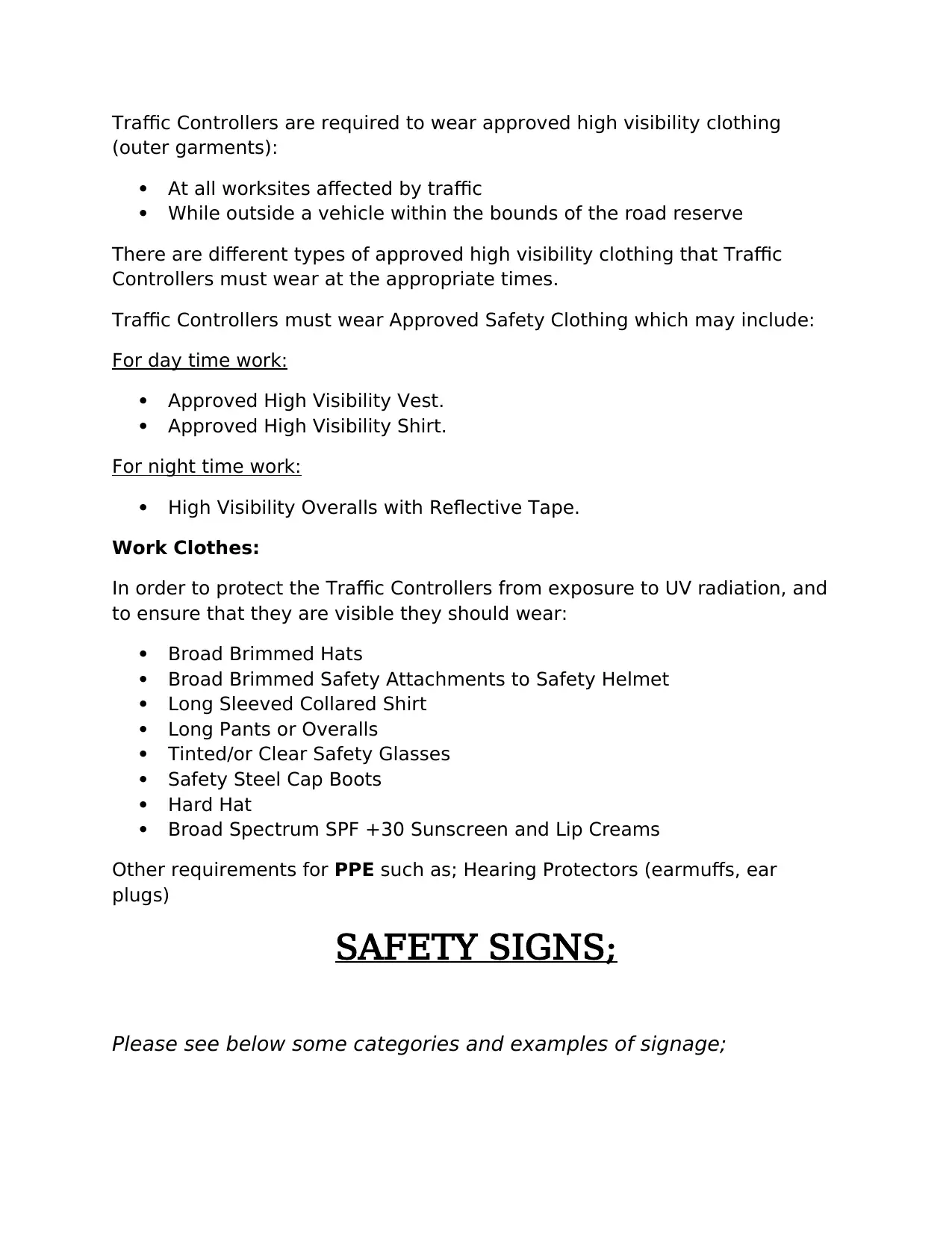
Traffic Controllers are required to wear approved high visibility clothing
(outer garments):
At all worksites affected by traffic
While outside a vehicle within the bounds of the road reserve
There are different types of approved high visibility clothing that Traffic
Controllers must wear at the appropriate times.
Traffic Controllers must wear Approved Safety Clothing which may include:
For day time work:
Approved High Visibility Vest.
Approved High Visibility Shirt.
For night time work:
High Visibility Overalls with Reflective Tape.
Work Clothes:
In order to protect the Traffic Controllers from exposure to UV radiation, and
to ensure that they are visible they should wear:
Broad Brimmed Hats
Broad Brimmed Safety Attachments to Safety Helmet
Long Sleeved Collared Shirt
Long Pants or Overalls
Tinted/or Clear Safety Glasses
Safety Steel Cap Boots
Hard Hat
Broad Spectrum SPF +30 Sunscreen and Lip Creams
Other requirements for PPE such as; Hearing Protectors (earmuffs, ear
plugs)
SAFETY SIGNS;
Please see below some categories and examples of signage;
(outer garments):
At all worksites affected by traffic
While outside a vehicle within the bounds of the road reserve
There are different types of approved high visibility clothing that Traffic
Controllers must wear at the appropriate times.
Traffic Controllers must wear Approved Safety Clothing which may include:
For day time work:
Approved High Visibility Vest.
Approved High Visibility Shirt.
For night time work:
High Visibility Overalls with Reflective Tape.
Work Clothes:
In order to protect the Traffic Controllers from exposure to UV radiation, and
to ensure that they are visible they should wear:
Broad Brimmed Hats
Broad Brimmed Safety Attachments to Safety Helmet
Long Sleeved Collared Shirt
Long Pants or Overalls
Tinted/or Clear Safety Glasses
Safety Steel Cap Boots
Hard Hat
Broad Spectrum SPF +30 Sunscreen and Lip Creams
Other requirements for PPE such as; Hearing Protectors (earmuffs, ear
plugs)
SAFETY SIGNS;
Please see below some categories and examples of signage;
Paraphrase This Document
Need a fresh take? Get an instant paraphrase of this document with our AI Paraphraser
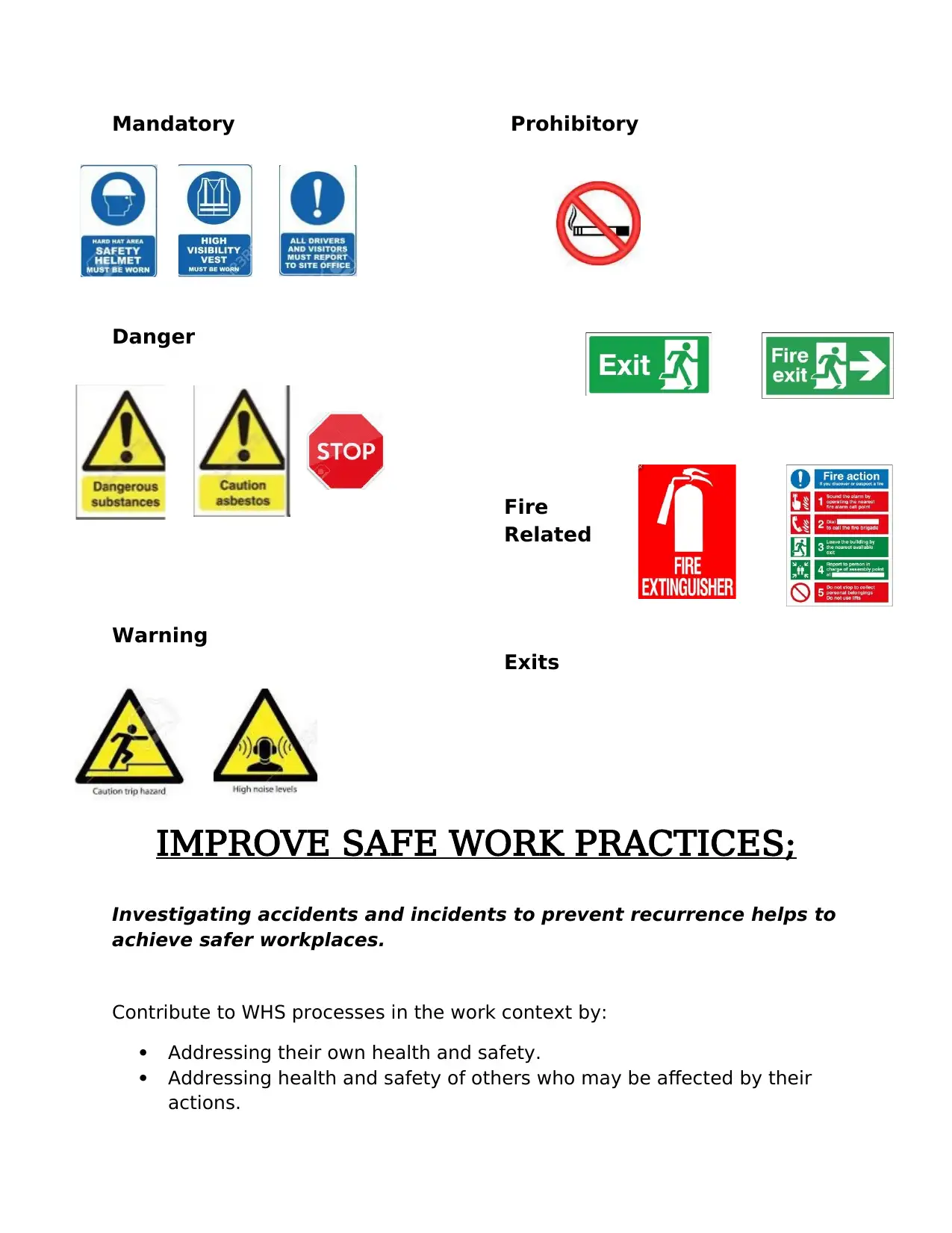
Mandatory Prohibitory
Danger
Warning
Fire
Related
Exits
IMPROVE SAFE WORK PRACTICES;
Investigating accidents and incidents to prevent recurrence helps to
achieve safer workplaces.
Contribute to WHS processes in the work context by:
Addressing their own health and safety.
Addressing health and safety of others who may be affected by their
actions.
Danger
Warning
Fire
Related
Exits
IMPROVE SAFE WORK PRACTICES;
Investigating accidents and incidents to prevent recurrence helps to
achieve safer workplaces.
Contribute to WHS processes in the work context by:
Addressing their own health and safety.
Addressing health and safety of others who may be affected by their
actions.
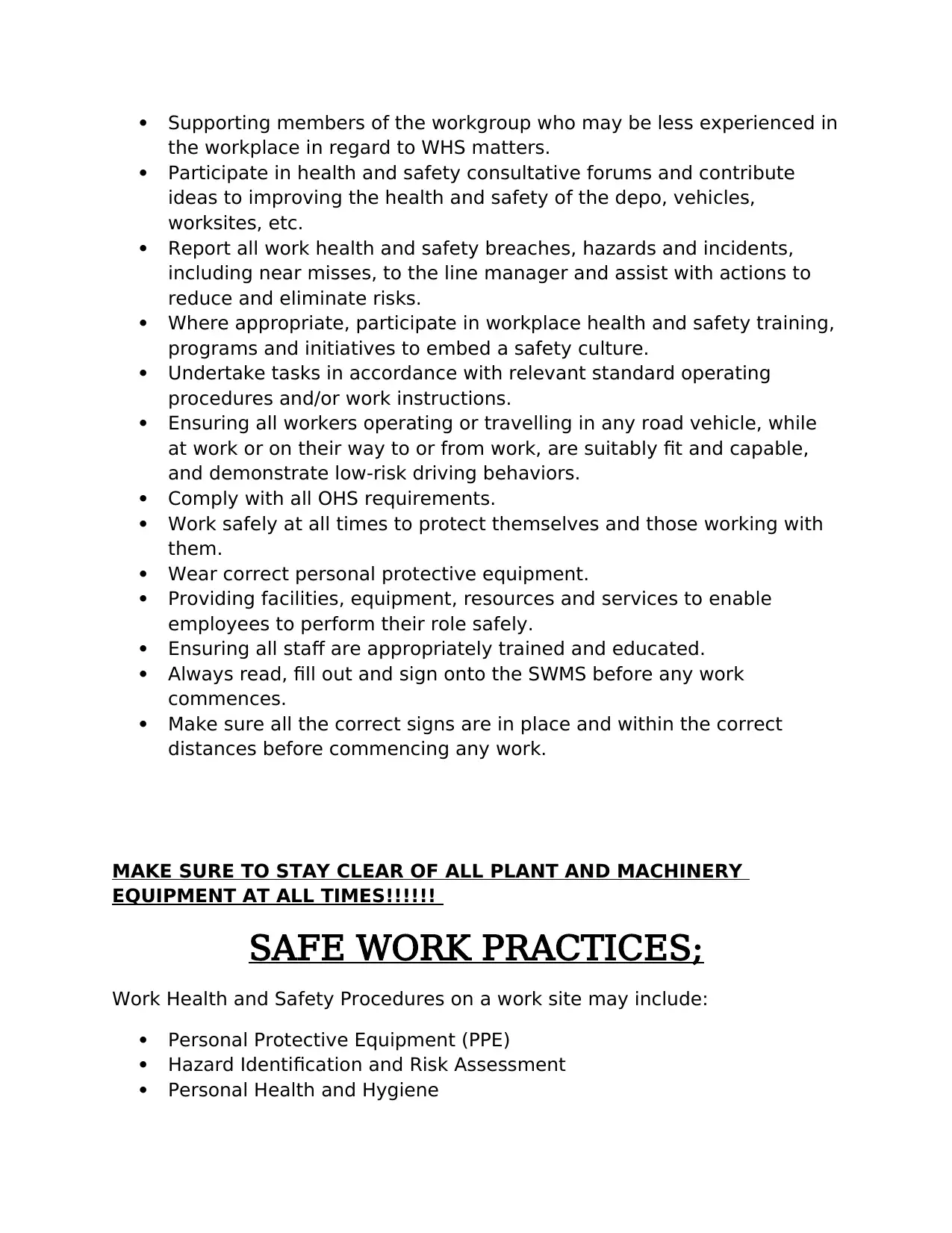
Supporting members of the workgroup who may be less experienced in
the workplace in regard to WHS matters.
Participate in health and safety consultative forums and contribute
ideas to improving the health and safety of the depo, vehicles,
worksites, etc.
Report all work health and safety breaches, hazards and incidents,
including near misses, to the line manager and assist with actions to
reduce and eliminate risks.
Where appropriate, participate in workplace health and safety training,
programs and initiatives to embed a safety culture.
Undertake tasks in accordance with relevant standard operating
procedures and/or work instructions.
Ensuring all workers operating or travelling in any road vehicle, while
at work or on their way to or from work, are suitably fit and capable,
and demonstrate low-risk driving behaviors.
Comply with all OHS requirements.
Work safely at all times to protect themselves and those working with
them.
Wear correct personal protective equipment.
Providing facilities, equipment, resources and services to enable
employees to perform their role safely.
Ensuring all staff are appropriately trained and educated.
Always read, fill out and sign onto the SWMS before any work
commences.
Make sure all the correct signs are in place and within the correct
distances before commencing any work.
MAKE SURE TO STAY CLEAR OF ALL PLANT AND MACHINERY
EQUIPMENT AT ALL TIMES!!!!!!
SAFE WORK PRACTICES;
Work Health and Safety Procedures on a work site may include:
Personal Protective Equipment (PPE)
Hazard Identification and Risk Assessment
Personal Health and Hygiene
the workplace in regard to WHS matters.
Participate in health and safety consultative forums and contribute
ideas to improving the health and safety of the depo, vehicles,
worksites, etc.
Report all work health and safety breaches, hazards and incidents,
including near misses, to the line manager and assist with actions to
reduce and eliminate risks.
Where appropriate, participate in workplace health and safety training,
programs and initiatives to embed a safety culture.
Undertake tasks in accordance with relevant standard operating
procedures and/or work instructions.
Ensuring all workers operating or travelling in any road vehicle, while
at work or on their way to or from work, are suitably fit and capable,
and demonstrate low-risk driving behaviors.
Comply with all OHS requirements.
Work safely at all times to protect themselves and those working with
them.
Wear correct personal protective equipment.
Providing facilities, equipment, resources and services to enable
employees to perform their role safely.
Ensuring all staff are appropriately trained and educated.
Always read, fill out and sign onto the SWMS before any work
commences.
Make sure all the correct signs are in place and within the correct
distances before commencing any work.
MAKE SURE TO STAY CLEAR OF ALL PLANT AND MACHINERY
EQUIPMENT AT ALL TIMES!!!!!!
SAFE WORK PRACTICES;
Work Health and Safety Procedures on a work site may include:
Personal Protective Equipment (PPE)
Hazard Identification and Risk Assessment
Personal Health and Hygiene
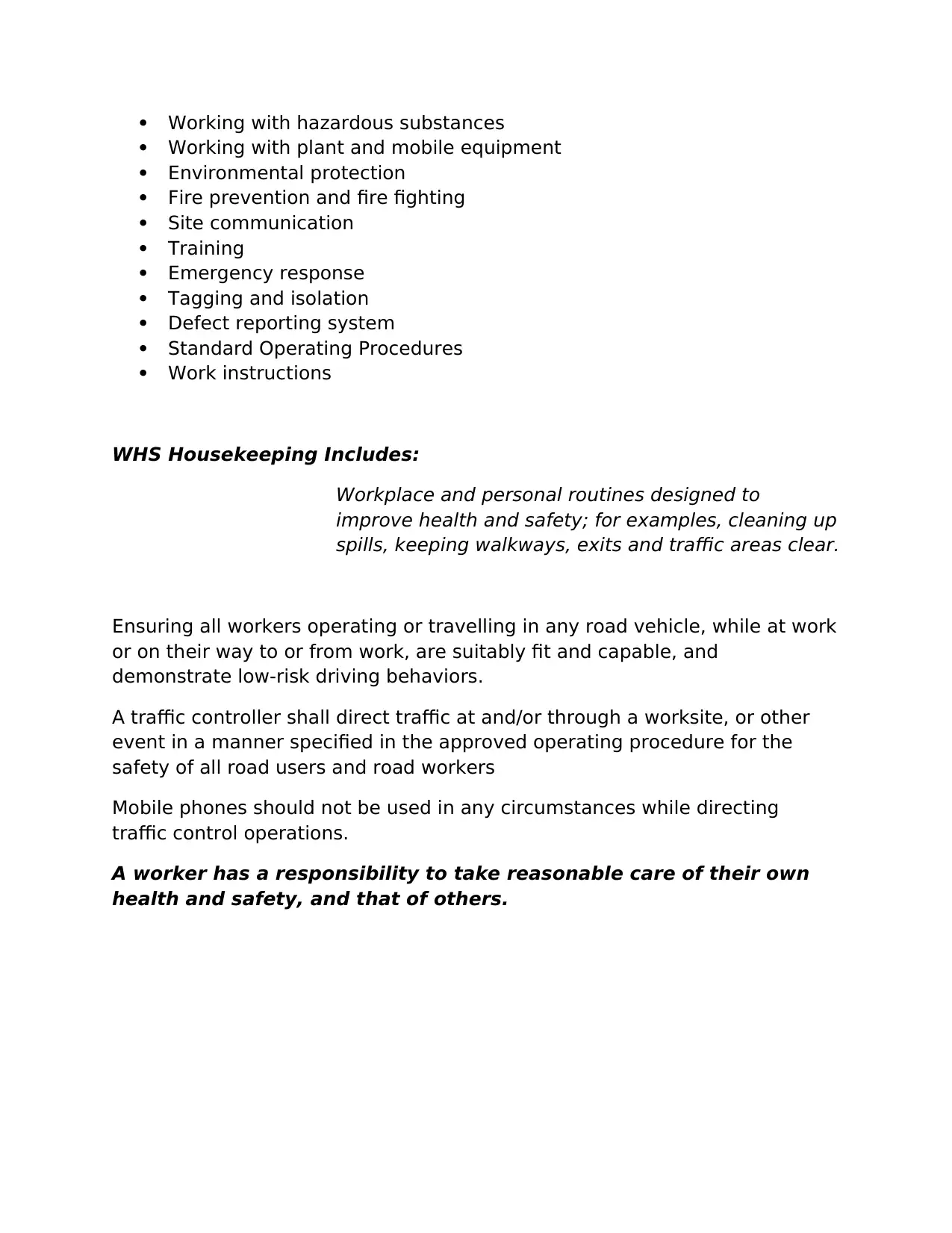
Working with hazardous substances
Working with plant and mobile equipment
Environmental protection
Fire prevention and fire fighting
Site communication
Training
Emergency response
Tagging and isolation
Defect reporting system
Standard Operating Procedures
Work instructions
WHS Housekeeping Includes:
Workplace and personal routines designed to
improve health and safety; for examples, cleaning up
spills, keeping walkways, exits and traffic areas clear.
Ensuring all workers operating or travelling in any road vehicle, while at work
or on their way to or from work, are suitably fit and capable, and
demonstrate low-risk driving behaviors.
A traffic controller shall direct traffic at and/or through a worksite, or other
event in a manner specified in the approved operating procedure for the
safety of all road users and road workers
Mobile phones should not be used in any circumstances while directing
traffic control operations.
A worker has a responsibility to take reasonable care of their own
health and safety, and that of others.
Working with plant and mobile equipment
Environmental protection
Fire prevention and fire fighting
Site communication
Training
Emergency response
Tagging and isolation
Defect reporting system
Standard Operating Procedures
Work instructions
WHS Housekeeping Includes:
Workplace and personal routines designed to
improve health and safety; for examples, cleaning up
spills, keeping walkways, exits and traffic areas clear.
Ensuring all workers operating or travelling in any road vehicle, while at work
or on their way to or from work, are suitably fit and capable, and
demonstrate low-risk driving behaviors.
A traffic controller shall direct traffic at and/or through a worksite, or other
event in a manner specified in the approved operating procedure for the
safety of all road users and road workers
Mobile phones should not be used in any circumstances while directing
traffic control operations.
A worker has a responsibility to take reasonable care of their own
health and safety, and that of others.
1 out of 10
Related Documents
Your All-in-One AI-Powered Toolkit for Academic Success.
+13062052269
info@desklib.com
Available 24*7 on WhatsApp / Email
![[object Object]](/_next/static/media/star-bottom.7253800d.svg)
Unlock your academic potential
© 2024 | Zucol Services PVT LTD | All rights reserved.





